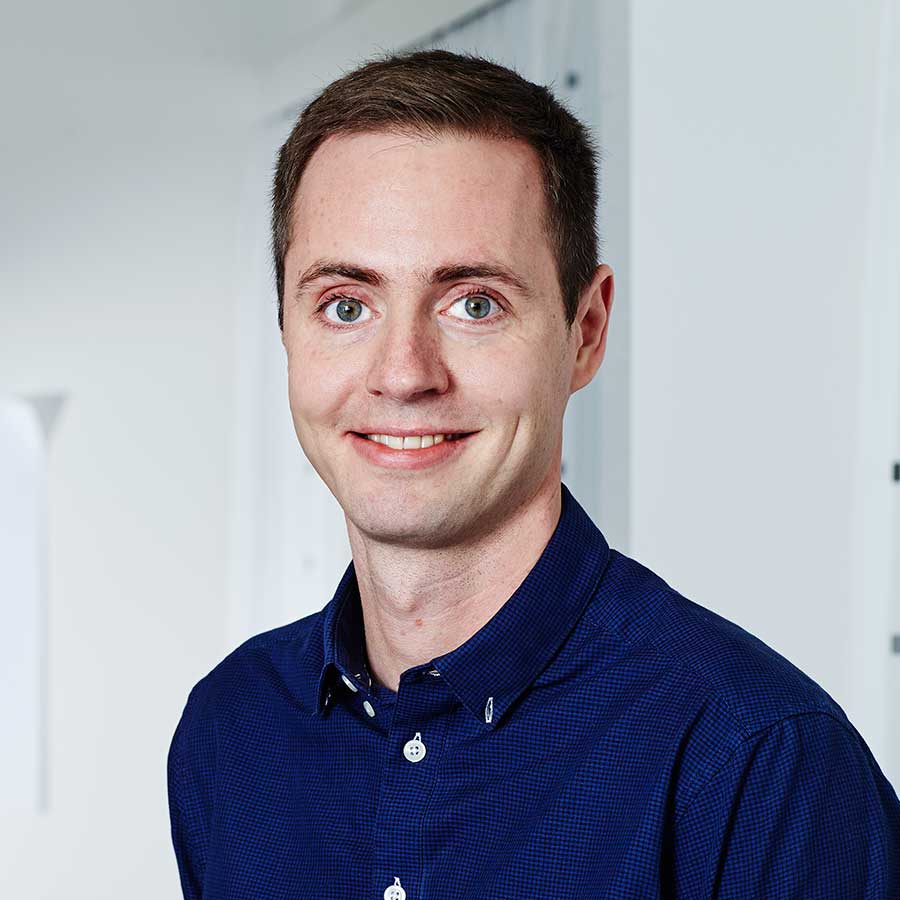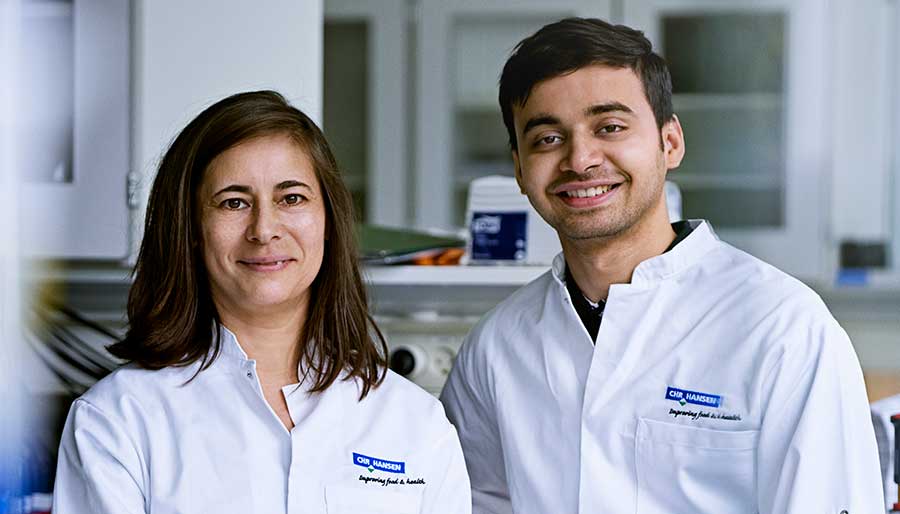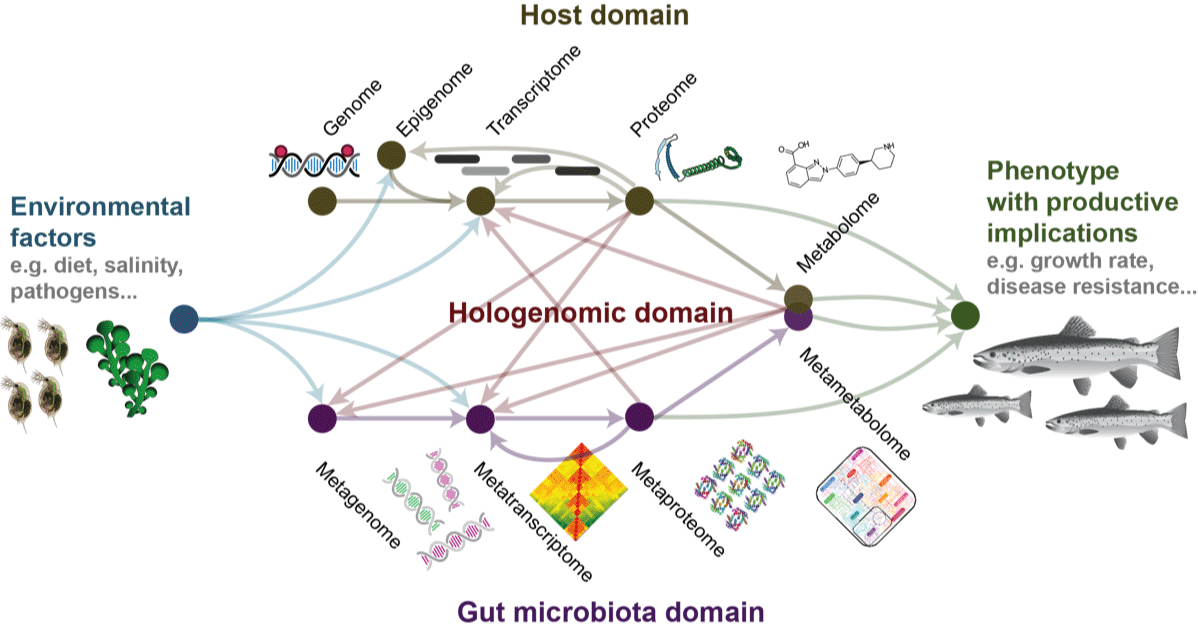Science-based innovation is at the very core of what we do. We start the process by learning all that we can from producers, nutritionists, veterinarians and others who are charged with the raising of production livestock and poultry. We ask many questions and dig deeply to truly understand their goals, aspirations, frustrations and pain points. Then, we go to our Innovation laboratories and look for ways in which our good bacteria can work to support the health and well-being of the animals in their care.
With many years of experience, we have come to completely trust in the power of good bacteria to support animal health, welfare and performance. The more we study these wonderful microbes, the more we realize how useful they are to anyone and everyone involved in production animal agriculture.
Take a tour of our Innovation lab
Meet our scientists
Erik Juncker Boll, Ph.D.
"I started working at Chr. Hansen in 2017 as a research scientist – initially as part of the Biosafety team. Later that same year, I joined the Innovation department in the Animal Health & Nutrition division. This gave me the opportunity to explore the many potential benefits of probiotics. I use cell line models to try to increase our understanding of how probiotics can support gut health, for instance by supporting the gut barrier.
Recently, I have also taken on a new exiting role as Innovation lead for the new pet segment. In this role I am learning new things every day. For instance, unlike farm animals – but much like humans – the main health issues dogs and cats are faced with are often related to lifestyles. Thankfully, I can leverage much of the science from Chr. Hansen’s Human Health department to help find the best probiotic solutions for dogs and cats."
Want to see what Erik published recently? Go to his ResearchGate profile.
Audrey Segura, Ph.D.
"After my Ph.D. in Molecular Microbiology obtained at the INRAe in France, I was relocated in Denmark to start a training program in the Innovation department in the Animal Health & Nutrition division. Here I was able to apply my knowledge on the carriage of pathogenic E. coli in ruminants. Later, I was hired as Customer Support Scientist in the same department. So far, I have had the opportunity to understand how knowledge generated by science can meet customer needs and support customer on overcoming practical challenges.
My focus area is to use different molecular techniques to understand the mode of action of probiotics when applied to livestock and companion animals. Recently, I have also taken a new exiting role as Innovation lead for the silage segment in which I drive and coordinate different activities from new product development to customer support."
Want to see what Audrey published recently? Go to her ResearchGate profile or Google Scholar profile.
Science is much better when shared with trusted partners
HoloFood an EU Project focus on Hologenomic
HoloFood is a Horizon2020 Innovation Action, comprising of 11 organizations from across Europe. The project with his 'hologenomic' approach that will improve the efficiency of food production systems by understanding the biomolecular and physiological processes affected by incorporating feed additives and novel sustainable feeds in farmed animals.
The HoloFood consortium will showcase the potential of an innovative solution that holds enormous potential for optimizing modern food production.
The ambition of the HoloFood solution is to create a versatile framework that can be applied in theory to any food production system that relies on the co-interaction of animals and their gut microorganisms.
The ambition of the HoloFood solution is to create a versatile framework that can be applied in theory to any food production system that relies on the co-interaction of animals and their gut microorganisms.
The holo-omic approach considers the holobiont (host animal and its associated microbiota) as a single unit of action, across multiple molecular levels. The project will deeply study and understand the interactions between the animal and their respective gut microbiome on numerous molecular levels. Genetic data will be complemented by other data set such us physiological and health information
This approach enables us to move beyond simply showing that feed affects the physical make-up of an animal (for example growth, quality, health, welfare or even gut microbiome community structure), but to actually understanding how the feed, host and microbes interact to yield these differences in animals.
We will use two critically important farmed animal systems as our models – salmon and chicken – and use the newly developed holo-omic framework to characterize not only their associated gut microorganisms’ whole genomes, transcriptomes and metabolomes, but also their genomes, intestinal transcriptomes and intestinal immune processes, all in relation to production performance parameters and animal welfare.
Chicken production has recently made huge efforts towards healthy, natural food production without use of chemicals or antibiotics in food systems. As such natural alternatives, such as prebiotic and probiotic additives to chicken feed have been a huge improvement. Nonetheless, the full impact of these natural alternatives, and the variation in chicken growth is still poorly understood.
HoloFood aims to investigate the effect and interplay between host (chicken) - microbiome in response to different dietary additives.
What to know more about HoloFood? Learn more at HoloFood or HoloFood - EU Project or Holo-Chicken.
1 https://www.sciencedirect.com/science/article/pii/S0167779918300015?via%3Dihub
This project has received funding from the European Unionʼs Horizon 2020 research and innovation program under grant agreement No 817729.




